Mar 28, 2024
Cooperative Intelligent Transport Systems (C-ITS) can increase road safety, help prevent accidents and improve traffic flow. The use of C-ITS also offers advantages when integrating automated vehicles into the existing traffic system. Within the framework of the EU project SHOW (SHared automation Operating models for Worldwide adoption), the interaction between automated vehicles and digital infrastructure is being tested at three Austrian pilot sites. In Graz, Carinthia and Salzburg, the partners are testing various solutions that help the vehicles in operation to master complex traffic situations more confidently.
The EU-project SHOW is not only enhancing the technology of automated vehicles and testing it in real-life scenarios, but also investigating the use of cooperative intelligent transport systems (C-ITS) and how they interact with automated vehicles and supporting infrastructure. This research is being conducted at three pilot sites in Austria.
The Graz pilot site is testing automated mobility in an urban environment as a service to complement public transport. Two fully automated cars transport passengers on a two-kilometer route between the Puntigam public transport hub and the "Center West" shopping center in Graz. In Puntigam, the automated vehicles receive support from C-ITS technology to optimize the passage through the busy transport hub.
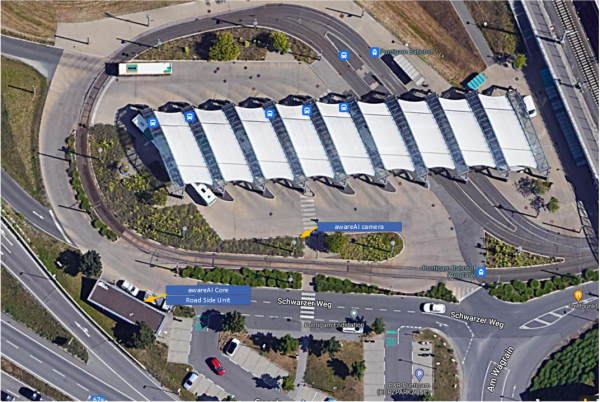
To check the occupancy of bus bays, Yunex Traffic installed an awareAI camera system and a Roadside Unit (RSU). The video stream captured by the awareAI system is analysed and processed locally only. The resulting bus bay occupancy information is then sent to the locally connected C-ITS RSU for continuous transmission via the ITS-G5 radio channel in the form of a free text message based on the IVI (In-Vehicle Information) messaging standard.
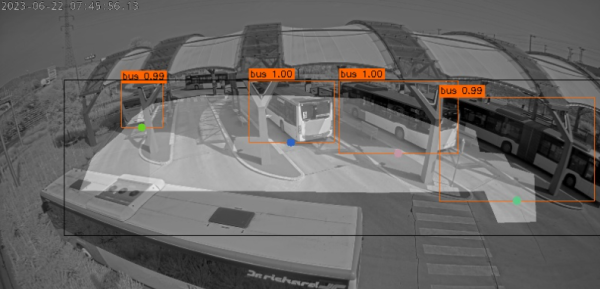
There are also tram lines that the fully automated vehicles cross as part of their route at the Puntigam public transport hub. The tram crossings are protected with a warning light that is triggered when a tram approaches. C-ITS functionality was added to these warning lights to send a C-ITS DENM (Decentralised Environmental Notification Message) in parallel.
The On-board Units (OBUs) of the automated vehicles can receive the bus bay occupancy messages and the warning signal. As OBU, the vehicleCAPTAIN toolbox is used. The messages received are fed into the vehicle's planning system and supplement the vehicle's sensors. This enables the vehicle to automatically select the first available bus stop and drive the route completely autonomously. Test drives have shown that this ensures smoother operation.
In Carinthia, applications of automated shuttles for passenger and freight transport are being tested in a complex traffic environment. In Klagenfurt am Wörthersee, automated shuttles will operate from spring 2024 on a route between the university, Lakeside Park, a research and technology centre, and a leisure park (Minimundus).
The planned route requires the vehicle to turn left at the exit of a car park (Park & Ride Klagenfurt West) and cross a pedestrian crossing. This turning situation is challenging. To ensure safe passage for all road users, the shuttle's sensor system is supported by external sensors when turning.
At the pedestrian crossing behind the intersection, the challenge is to detect all road users and their respective positions and speeds.
The purpose of integrating information from the digital infrastructure is to enhance the capabilities of the vehicle sensors, specifically in identifying road users on the crossing. To achieve this, the awareAI camera system from Yunex Traffic is utilised. The camera is mounted on a traffic light pole, six metres above theroad, to detect both the pedestrian crosswalk and the adjacent pavement, and to locally identify vulnerable road users.
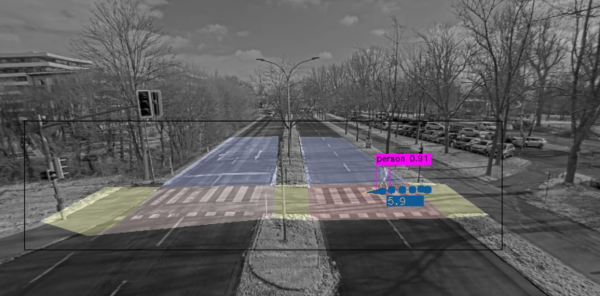
The intelligent infrastructure triggers a warning signal only when pedestrians or cyclists are present in the relevant areas. The warning message is provided by the awareAI system and is sent by the RSU as an ETSI standard DENM message over the ITS-G5 radio channel.
Furthermore, this RSU and three other Yunex Traffic Roadside Units along the route continuously transmit the current signalling status of the traffic light-controlled intersection in the form of SPATEM (Signal Phase and Timing) messages. The junction topology of the respective intersection is transmitted by MAPEM (MAP (topology) Extended Message) messages to enable a clear assignment of the signal states to the topology. These messages are receivable by all vehicles equipped with a corresponding OBU.
In spring 2023, the intelligent infrastructure was tested in Klagenfurt using the AustriaTech Mobile Lab to verify and validate C-ITS messages. During the test, the Mobile Lab reported a message from the RSU every time a person crossed the zebra crossing, and the communication worked flawlessly. This means that the shuttle can now utilise the information without any hindrance.
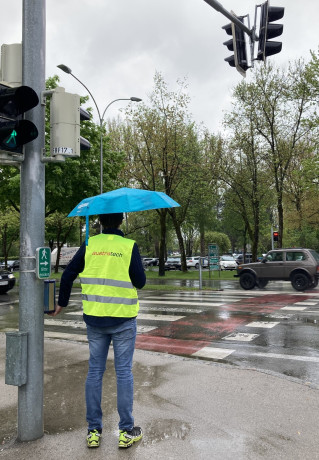
Automated vehicles are currently being utilized at the pilot site in Salzburg to enhance public transport connections to the village of Koppl. These vehicles link the Koppl Sperrbrücke bus stop, which is serviced by buses along the B158, with the town centre, effectively closing the gap in the first/last mile. Further digital infrastructure will be implemented to optimize the use of automated vehicles in Koppl and along the bus line to Salzburg city. Five Roadside Units (RSUs) send out information on positioning, collision risk and the detection of vulnerable road users.
In the "Public Transport vehicle at a stop" use case, predefined locations and their trigger areas are stored in the Onboard Unit (OBU) of the automated vehicle. As soon as the vehicle reaches the defined trigger area, the OBU sends the specific warning message "Stationary vehicle – public transport stop" (see illustration, left). C-ITS-capable vehicles receive this message and forward it to the central system. If an ITS-G5 RSU is in the vicinity, this unit also sends the message to the central system.
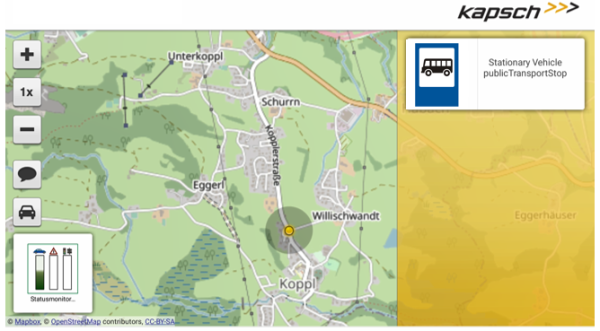
The "Public Transport Vehicle Crossing" use case is relevant if, for example, an automated vehicle enters a priority road or performs a left turn manoeuvre and crosses oncoming traffic. Here too, the trigger areas must be defined in advance and saved in the OBU. The warning messages are then sent to vehicles and ITS-G5 RSUs in the vicinity as "Collision Risk" (see illustration on the right). This exchange of information between the infrastructure and the automated vehicle increases road safety.
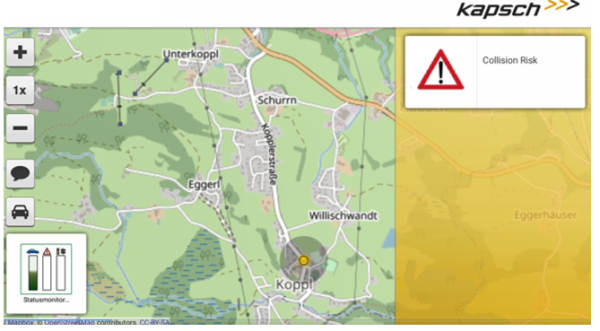
Along the corridor to Salzburg, three additional RSUs have been installed. The main objective is to ensure the smooth passage of public transport buses into the city, which enhances road safety and optimises traffic flow. The RSUs transmit messages on various aspects, including hazard messages such as weather warnings, roadworks notices, in-vehicle signage, and the collection of vehicle and incident data.
Especially at traffic light intersections along the bus corridor, information about the current traffic light phase is transmitted and use cases for bus priority are tested.